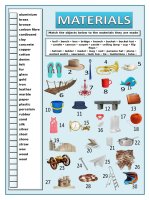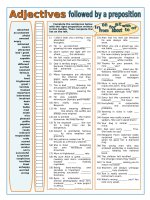islcollective worksheets preintermediate a2 intermediate b1 adults high school reading speaking passive voice environmen 11683160054cc10c5f278f4 76167272
Bạn đang xem bản rút gọn của tài liệu. Xem và tải ngay bản đầy đủ của tài liệu tại đây (416.57 KB, 2 trang )
When most people look at a painting of a sunset, they see a beautiful work of art. When Professor Christos
Zerefos looks at a painting of a sunset, he sees valuable scientific evidence. He believes that these
paintings contain important information about the effect of volcanoes on the climate.
Scientists know that after a volcanic eruption, sunsets are very red. This is caused by the dust and ash
that are sent into the sky. Volcanoes also lower the temperature of the Earth.
Professor Zerefos and his team decided to study paintings of sunsets before and after volcanic eruptions.
Red sunsets are a sign of polluted skies, so the scientists believed that landscapes that were painted after
major volcanic eruptions would have bright red sunsets. They wanted to use the paintings to measure how
the volcanoes had affected the climate in the past.
More than 500 watercolours and oils of sunsets that were painted between the years 1500 and 1900 have
been studied by a team of experts. Professor Zerefos had the results analysed by a computer. The
computer calculated the amount of red in each picture. They found that the sunsets that were painted
after a volcanic eruption were bright red.
Many scientists are not convinced by this theory. According to them, it is impossible to make scientific
conclusions based on art that was painted so long ago, because it is possible that the colours have changed
since they were originally painted. What is more, artists often try to make something look very impressive
when they paint. As a result, they may not always paint an accurate picture of nature.
Professor Zerefos disagrees. He is certain that artists accurately copy the actual colours of the sunsets
they see. Paintings that were painted in the 20 th century are now being studied by Professor Zerefos and
his team.
So the next time you look at a painting of a beautiful sunset, examine the colours more carefully .
1.
Read the text. Then answer the questions. Write complete sentences.
1. Why did Professor Zerefos study paintings of sunsets?
2. Why are sunsets very red after a volcanic eruption?
3. Explain the meaning of the title.
2. Complete the first part of the sentences with the correct passive form of the verb in brackets.
Then complete the second part of the sentences according to the information found in the text.
1. The
Earth’s
temperature
___________________________
(lower)
by
___________________________________
2. In
the
past,
bright
red
sunsets
____________________________
(paint)
________________________________
3. More
than
500
paintings
_____________________
of
sunsets
_______________________________
(examine)
4. In
the
study,
a
computer
____________________________
(use)
to
____________________________________
5. According
to
some
scientists,
nature
_________________________
(not
copy)
_________________________
KEY
1
1. Because he believes that these paintings contain important information about the effect of
volcanoes on the climate.
2. Because a lot of dust and ash is sent into the sky.
3. There is more than just beauty in the painting of a landscape.
2
1. is lowered; volcanoes
2. were painted; after major volcanic eruptions
3. have been examined; by a team of experts
4. was used; analyse the results / calculate the amount of red in each picture
5. isn’t copied; accurately by artists
ADDITIONAL TASK:
Describe a painting that you have seen. Explain why you like it and how it makes you feel.
Here
you are an awe-inspiring example:
Whakaari Volcano
This living volcano that can erupt at any time, is situated 48 kilometres out at the sea in New Zealand,
belonging to the Taupo Volcanic Zone, and stands right where the Pacific and Indian Australian plates
collide.
/>









